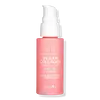What's inside
What's inside
 Key Ingredients
Key Ingredients

 Benefits
Benefits

 Concerns
Concerns

 Ingredients Side-by-side
Ingredients Side-by-side

Water
Skin ConditioningButylene Glycol
HumectantGlycerin
HumectantPEG-150 Distearate
EmulsifyingPolysorbate 80
EmulsifyingNiacinamide
SmoothingRosmarinus Officinalis Leaf Water
MaskingMelissa Officinalis Flower/Leaf/Stem Water
Skin ConditioningMentha Piperita Leaf Water
Skin ConditioningSodium Hyaluronate
HumectantSodium Ascorbyl Phosphate
AntioxidantMenthol
MaskingPentylene Glycol
Skin ConditioningPropylene Glycol
HumectantPEG-240/Hdi Copolymer Bis-Decyltetradeceth-20 Ether
StabilisingPEG-40 Hydrogenated Castor Oil
EmulsifyingPhenoxyethanol
PreservativeEthylhexylglycerin
Skin ConditioningCaprylyl Glycol
EmollientDisodium EDTA
Trideceth-9
Emulsifying1,2-Hexanediol
Skin ConditioningCI 42090
Cosmetic ColorantCI 19140
Cosmetic ColorantWater, Butylene Glycol, Glycerin, PEG-150 Distearate, Polysorbate 80, Niacinamide, Rosmarinus Officinalis Leaf Water, Melissa Officinalis Flower/Leaf/Stem Water, Mentha Piperita Leaf Water, Sodium Hyaluronate, Sodium Ascorbyl Phosphate, Menthol, Pentylene Glycol, Propylene Glycol, PEG-240/Hdi Copolymer Bis-Decyltetradeceth-20 Ether, PEG-40 Hydrogenated Castor Oil, Phenoxyethanol, Ethylhexylglycerin, Caprylyl Glycol, Disodium EDTA, Trideceth-9, 1,2-Hexanediol, CI 42090, CI 19140
Water
Skin ConditioningEthylhexyl Olivate
Skin ConditioningStearyl Alcohol
EmollientCetyl Alcohol
EmollientHelianthus Annuus Seed Oil
EmollientCaprylic/Capric Triglyceride
MaskingCoco-Caprylate
EmollientGlyceryl Stearate
EmollientEthyl Macadamiate
Skin ConditioningSr-Hydrozoan Polypeptide-1
HumectantSodium Hyaluronate
HumectantCaffeine
Skin ConditioningCitrus Aurantium Dulcis Flower Extract
Skin ConditioningAstrocaryum Tucuma Seed Butter
EmollientCarthamus Tinctorius Seed Oil
MaskingJasminum Officinale Extract
MaskingTocopherol
AntioxidantSqualane
EmollientPropanediol
SolventCaprylhydroxamic Acid
Caprylyl Glycol
EmollientLauroyl Lysine
Skin ConditioningOctyldodecyl Oleate
EmollientButyrospermum Parkii Butter
Skin ConditioningMica
Cosmetic ColorantTin Oxide
AbrasiveGlycerin
HumectantXanthan Gum
EmulsifyingStearyl Phosphate
EmulsifyingSodium Gluconate
Skin ConditioningCitric Acid
BufferingSodium Hydroxide
BufferingSodium Benzoate
MaskingParfum
MaskingCI 77891
Cosmetic ColorantCI 77491
Cosmetic ColorantWater, Ethylhexyl Olivate, Stearyl Alcohol, Cetyl Alcohol, Helianthus Annuus Seed Oil, Caprylic/Capric Triglyceride, Coco-Caprylate, Glyceryl Stearate, Ethyl Macadamiate, Sr-Hydrozoan Polypeptide-1, Sodium Hyaluronate, Caffeine, Citrus Aurantium Dulcis Flower Extract, Astrocaryum Tucuma Seed Butter, Carthamus Tinctorius Seed Oil, Jasminum Officinale Extract, Tocopherol, Squalane, Propanediol, Caprylhydroxamic Acid, Caprylyl Glycol, Lauroyl Lysine, Octyldodecyl Oleate, Butyrospermum Parkii Butter, Mica, Tin Oxide, Glycerin, Xanthan Gum, Stearyl Phosphate, Sodium Gluconate, Citric Acid, Sodium Hydroxide, Sodium Benzoate, Parfum, CI 77891, CI 77491
 Reviews
Reviews

Ingredients Explained
These ingredients are found in both products.
Ingredients higher up in an ingredient list are typically present in a larger amount.
Caprylyl Glycol is a humectant and emollient, meaning it attracts and preserves moisture.
It is a common ingredient in many products, especially those designed to hydrate skin. The primary benefits are retaining moisture, skin softening, and promoting a healthy skin barrier.
Though Caprylyl Glycol is an alcohol derived from fatty acids, it is not the kind that can dry out skin.
This ingredient is also used as a preservative to extend the life of products. It has slight antimicrobial properties.
Learn more about Caprylyl GlycolGlycerin is already naturally found in your skin. It helps moisturize and protect your skin.
A study from 2016 found glycerin to be more effective as a humectant than AHAs and hyaluronic acid.
As a humectant, it helps the skin stay hydrated by pulling moisture to your skin. The low molecular weight of glycerin allows it to pull moisture into the deeper layers of your skin.
Hydrated skin improves your skin barrier; Your skin barrier helps protect against irritants and bacteria.
Glycerin has also been found to have antimicrobial and antiviral properties. Due to these properties, glycerin is often used in wound and burn treatments.
In cosmetics, glycerin is usually derived from plants such as soybean or palm. However, it can also be sourced from animals, such as tallow or animal fat.
This ingredient is organic, colorless, odorless, and non-toxic.
Glycerin is the name for this ingredient in American English. British English uses Glycerol/Glycerine.
Learn more about GlycerinSodium Hyaluronate is hyaluronic acid's salt form. It is commonly derived from the sodium salt of hyaluronic acid.
Like hyaluronic acid, it is great at holding water and acts as a humectant. This makes it a great skin hydrating ingredient.
Sodium Hyaluronate is naturally occurring in our bodies and is mostly found in eye fluid and joints.
These are some other common types of Hyaluronic Acid:
Learn more about Sodium HyaluronateWater. It's the most common cosmetic ingredient of all. You'll usually see it at the top of ingredient lists, meaning that it makes up the largest part of the product.
So why is it so popular? Water most often acts as a solvent - this means that it helps dissolve other ingredients into the formulation.
You'll also recognize water as that liquid we all need to stay alive. If you see this, drink a glass of water. Stay hydrated!
Learn more about Water